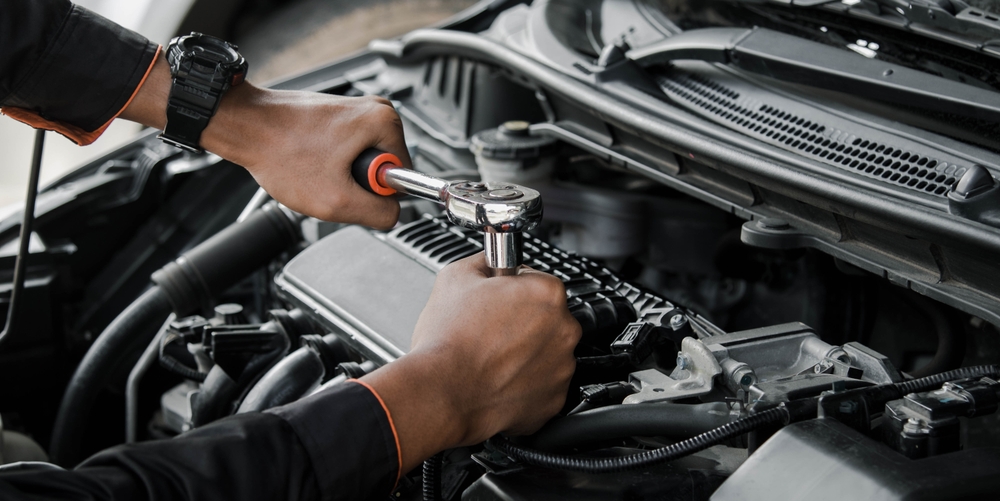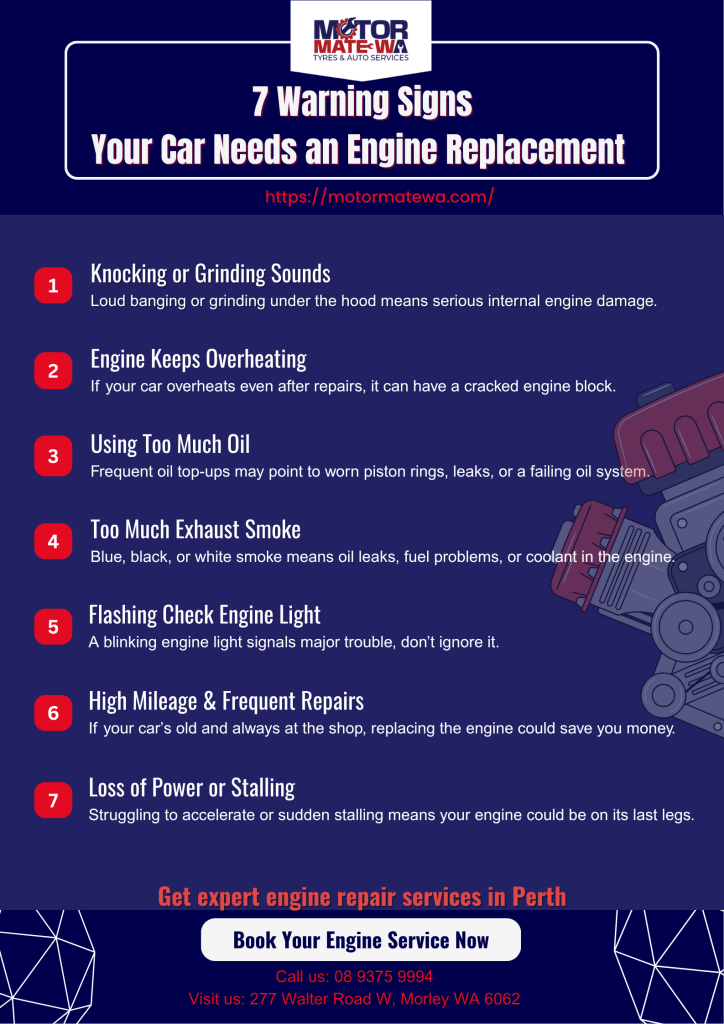Is Your Car’s Engine Failing? Here’s Your Complete Guide to Engine Replacement

Noticed your car acting a little strange lately? Maybe it’s stalling frequent, making odd knocking sounds, or puffing out smoke from the exhaust? If so, your precious ride might be showing signs of serious engine failure. And it might not be a simple fix.
We know, the thought of replacing an engine sound big and expensive. But sometimes, it’s the smartest and reliable way to keep your car running smoothly, safely, and cost-effectively in the long run.
At Motor Mate WA, our expert mechanics are here to make the process simple.
We’ll help you spot the engine failure signs, understand what engine replacement involves, and give you a clear idea of the repair costs. And if something feels off with your engine, contact us today for a complete engine diagnostic and professional advice.
Now, let’s explore what engine replacement really means and when it’s most needed.
What is a Car Engine Replacement | Why Do You Need One?
Engine replacement is the process of removing your car’s current engine, usually damaged, worn-out, or completely dead, and swapping it with a new, rebuilt, or reconditioned one.
It’s not a quick fix. And yes, it can be a bit pricey. But when done right, it can extend your car’s life by years and improve its overall performance.
So, why would you replace an engine? There are several reasons you might need an engine replacement:
- Complete engine failure – Your engine refuses to run or keeps breaking down. Here, repairing may not be enough. Swapping it out could be your only option.
- Too costly to repair – Sometimes, fixing a heavily damaged engine costs more than replacing it altogether. Especially in older cars with high mileage.
- You want better performance or fuel efficiency – Some drivers choose to upgrade to a more powerful or fuel-efficient engine to enhance performance or save on fuel costs.
Wondering when should you consider changing your car’s engine? Let’s explore the common symptoms of engine failure to help you figure it out.
7 Warning Signs Your Car Needs an Engine Replacement ASAP

Getting an engine replaced is a big decision, both mechanically and financially. That’s why it’s important to understand the signs before committing. Sometimes, the problem could be as simple as a faulty sensor or dirty engine bay. But if these symptoms below keep popping up, it might be time for a full engine replacement:
1. Strange Engine Noises Like Knocking or Grinding
If your car sounds like it’s groaning or rattling under the hood, don’t ignore it. They’re not just signs, they’re red flags.
Common concerning noises include:
- Knocking – Caused by worn-out engine bearings. This gets louder as you accelerate.
- Tapping/Clicking – A sign of low oil pressure or an issue with valve lifters.
- Grinding – Indicates serious internal damage, where metal parts are rubbing against each other.
2. You Engine Keeps Overheating
Your car’s temperature gauge keeps shooting toward the red zone? Or you see steam or smoke pouring out from under the hood? It’s overheating. Persistent overheating can point to serious engine problems like a cracked engine block.
Moreover, a cracked block can cause coolant to leak into the oil system. This can ruin the engine. If your car can’t stay cool even after repairs, it might be time to think about an engine replacement.
3. Engine Oil Issues or Frequent Top-Ups
Are you topping off the engine oil more often than usual even after a fresh oil change? That’s not normal. Excessive oil use can be a sign of:
- a failing oil pump
- clogged oil passages
- worn piston rings or leaking gaskets
4. Too Much Smoke Coming Out of Exhaust Pipe
A little exhaust is normal. But plumes of coloured smoke? Not so much. The colour of the smoke can tell you a lot about what’s happening inside your engine. Here’s how:
Smoke Colour | Possible Cause | What It Means |
Blue Smoke | Worn piston rings or valve seals | Engine oil is leaking into the combustion chamber and burning |
Black Smoke | Faulty fuel injectors | Too much fuel is being burned, which reduces fuel efficiency |
White Smoke | Cracked engine block or blown head gasket | Coolant is leaking into the combustion chamber, which can lead to engine damage |
5. You Engine Light Keeps Flashing
That glowing check engine light is your car’s built-in alert system. If the light is steady, the issue can be minor. But if it’s blinking rapidly, that means there’s a serious problem with your engine.
Don’t ignore a flashing check engine light. In many cases, it means urgent action is needed to prevent total engine failure.
6. High Mileage & Constant Repairs
Every car ages, and as the odometer climbs. So do the repair bills. High-mileage vehicles mostly face multiple engine-related issues, from faulty components to poor performance. If you’re constantly visiting the mechanic and nothing seems to hold up, replacing the engine could actually save you money in the long run.
7. Sudden Loss of Power or Stalling
Is your car sluggish, struggling to accelerate, or losing power mid-drive? That could mean trouble in the engine bay. Causes can include:
- a worn-out engine
- a clogged fuel filter
- ignition system problems
If your car suddenly loses power, pull over safely and get it checked right away. Continuing to drive could do even more damage.
5 Easy Steps Involved in Engine Replacement
Replacing a car engine isn’t your average repair job. It’s a big task that calls for experience, the right tools, and attention to detail. Here’s a simple breakdown of how the engine replacement process works from start to finish.
Step #1: Engine Diagnosis & Damage Inspection
Before getting into the replacement, a qualified mechanic will first run a full engine diagnostic. This helps confirm the root cause of the engine failure. Be it’s worn parts, oil issues, or overheating, and checks if any other nearby systems (like the cooling or fuel system) have been affected.
Step #2: Removing the Old Engine
Problem confirmed? Now, it’s time to remove the old engine.
This involves disconnecting the battery, draining fluids, and carefully unhooking all the hoses, wires, and mounts that link the engine to your car. The old engine is then lifted out of the engine bay.
Step #3: Preparing the Replacement Engine
If you’re using a remanufactured or used engine, the mechanic will inspect it thoroughly. Any worn-out parts (like gaskets or belts) are replaced. And necessary upgrades or fittings are added to make sure the new engine is compatible with your car model.
Step #4: Installing the New Engine
With everything ready, the new engine is carefully installed into the car. It’s connected to the transmission, exhaust, radiator, sensors, and all other essential systems. The mechanic will also ensure all bolts are torqued correctly and everything is aligned perfectly.
Step #5: Testing and Quality Checks
Once the new engine is in place, your car isn’t ready to hit the road just yet. The mechanic will run a series of tests, including checking for leaks, ensuring sensors are responding, and verifying that the engine runs smoothly under different conditions. Only after everything passes inspection will your car be good to go.
Tips to Extend the Life of Your New Car Engine
After replacement, protect your new engine with these simple tips:
- Stick to regular car servicing schedules. Schedule oil changes every 5,000–10,000 km. Check the engine cooling system and inspect sensors and relays to catch issues early.
- Always use quality engine oil & coolant to protect internal parts and maintain the engine cooling system’s efficiency
- Avoid harsh acceleration when the engine is cold. Drive gently for the first few minutes to help oil circulate. This reduces wear on components like pistons and the power steering system.
- Don’t ignore engine warning lights. These could signal issues with sensors and relays or the charging and starting systems.
- Keep an eye on oil, coolant, & power steering fluid levels. Low fluids can starve your engine or overheat the cabin air conditioner system, leading to costly repairs. Pop the hood monthly or visit us for a quick engine check.
How Much Does Engine Replacement Cost in Australia?
On average, engine replacement in Australia costs between $3,000 and $11,000, depending on the vehicle’s type and service provider. In Perth, the engine replacement cost ranges from $1,500 to $5,000.
Now, let’s look at the main factors that affect how much you’ll pay for an engine swap.
7 Factors that Affect Engine Replacement Costs
1. Vehicle Make and Model
High-performance or turbocharged engines like those in the Ford Ranger 3.2 or Mazda BT-50 are more expensive. Older models like the Holden Commodore VE can also cost more due to rare parts.
2. Engine Type and Size
Engine replacement costs in Australia vary depending on the type and size of the engine. Below is a quick breakdown of average prices for the three most common engine types.
Engine Type | Average Replacement Cost (AUD) | Key Notes |
Gasoline | $3,500 – $6,500 | Most affordable. Costs may rise for high-performance or luxury vehicles. |
Diesel | $5,000 – $12,500 | More expensive due to complex parts like turbochargers. Common in 4WDs, utes, and SUVs. |
Hybrid | $6,000 – $15,000+ | Highest cost due to advanced components and battery integration. |
Engine size and complexity also influence pricing. Larger engines or those with turbochargers typically cost more to replace.
3. Engine Condition
New engines can cost upwards of $29,000 but offer full warranties. Used engines are cheaper but can have hidden issues. Rebuilt or reconditioned engines strike a balance between cost and reliability.
4. Parts and Materials Needed
Essential parts like the engine block, cylinder head, pistons, and crankshaft contribute heavily to total cost. High-quality or OEM parts are pricier but more reliable.
5. Additional Repairs or Upgrades
Installing a new engine might require:
- Transmission adjustments
- Cooling system upgrades
- Electrical reprogramming (ECU)
- Fuel system enhancements
- Engine mount and drivetrain checks
These extras can add to the total cost significantly.
6. Warranty Coverage
If your engine fails due to a manufacturing defect, it can be covered under the vehicle’s warranty. Otherwise, you’ll need to bear the full replacement cost.
7. Labour Costs
Labour costs for engine replacement can vary widely depending on where you go. Typically, dealerships charge between $300 and $400 per hour. Independent garages are mostly 20–40% cheaper.
If you hire a mobile mechanic, you can save on towing but expect extra call-out fees. Since engine replacement usually takes time, the total labour time plays a big role in the final cost.
How Long Does It Take to Replace Car Engine?
On average, engine replacement takes 8 to 15 hours of hands-on work to complete the process.
However, depending on your car’s make and model, it could take longer, especially if you need extra upgrades or the replacement engine doesn’t perfectly match the original. Note that the labour takes about half a day. A big chunk of your wait time might come from things like arranging towing, sourcing the engine, or waiting for parts to arrive.
Engine trouble? Noticed strange noises, smoke, or warning lights? Don’t let it slow you down.
Get Expert Engine Replacement Services in Perth at Motor Mate WA Today
Whether your engine is knocking, smoking, or just not starting, we’re here to help you get back on the road safely. Our experienced mechanics offer:
- Comprehensive Engine Diagnostics
- Engine Fine-tuning
- Engine Block Overhaul
- Clutch & Cylinder Checks
- Fuel Injection & Ignition Repair
- Emissions & Fuel Consumption Control
Don’t wait for a total breakdown. Talk to our team today for honest advice, competitive quotes, and reliable service you can trust.
Call us at 08 9375 9994
